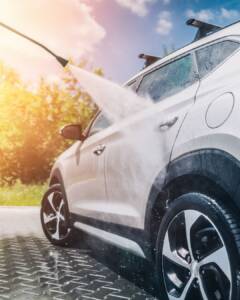Sticky Situation: A Guide To Remove Pine Sap From Your Car

Picture this: you’re parked under a serene pine tree, enjoying the shade on a sunny day. Sounds idyllic, right? Until you notice those pesky sticky spots of pine sap decorating your car’s sleek paint job. Suddenly, serenity turns into a sticky situation! How do you remove that pine sap from your car?
Pine sap can be a real nuisance, stubbornly clinging to your car’s surface and defying your best efforts to remove it. But fear not, fellow car enthusiasts, for we have the ultimate guide to banishing pine sap and restoring your car’s shine.
In this blog post, we’ll dive into the science behind pine sap’s sticky grip, explore common misconceptions about removal methods, and unveil the tried-and-true techniques that will leave your car looking as good as new. Whether you’re a seasoned car care aficionado or a newbie in the world of automotive maintenance, this guide is your go-to resource for conquering pine sap woes.
So buckle up and get ready to bid farewell to sticky situations. Your car’s paint deserves to shine, sap-free and splendid!
What is tree sap?
Why is tree sap so damaging?
How soon can tree sap damage my car’s paint?
How to remove pine sap from your vehicle
What is tree sap?
Tree sap is the sticky liquid within a tree that contains minerals and nutrients. Much like blood in humans and other creatures, tree sap spreads down the branches and limbs, bringing energy to help generate new growth, like buds in the springtime.
The phloem is what makes tree sap so sticky; it is made of sugars created by photosynthesis and then fed back to the tree for energy. Sap also acts as a defense for trees against bugs, as it can form a sticky, hardened prison for the offending pests.
Why is tree sap so damaging?
The damage that tree sap, like pine sap, can cause is twofold. Not only can it eat away at the clear coat of your vehicle’s paint, causing etching, but due to its extreme stickiness and tendency to shrink when exposed to heat, it can bond so strongly with your vehicle’s paint that the tension created can crack your vehicle’s finish.
Etching removes the clear coat’s ability to protect your vehicle from various elements, like rain and sun damage, by creating a hole in the overall protective coating above the paint.
When the sap’s bond with the paint has caused it to crack and peel, you’re exposing your metal frame to damaging elements and increasing the likelihood of rust and corrosion ruining your vehicle’s frame.
How soon can tree sap begin to damage my car’s paint?
It can be challenging to put a timeline on when the sap will begin to damage your vehicle’s paint because of factors such as climate, weather, and seasons. When sap first falls onto your car, it’s soft, sticky, and more liquid. In this form, it’s the easiest to remove. In fact, the earlier, the better. However, when sap is exposed to heat, it can harden into a type of resin, which makes it much more difficult to remove without extra products, elbow grease, and potentially damaging your vehicle’s paint job.
Our best advice is to try to remove sap spots when you first see them rather than giving them time to ‘bake’ on, especially in the summer months, which can be hot and dry.
How to remove pine sap from your car
Items you may need:
- microfiber cloth
- isopropyl alcohol or denatured alcohol
- hand sanitizer
- specialized bug/tar or tree sap remover products like Goo Gone, Krud Kutter, or Nanoskin
- hot water (for tougher, dried-on sap)
- cotton balls
Step 1: Thoroughly wash your vehicle with a car wash. Not only does this help your car and potentially remove some sap, but it may also
Step 2: Treat the sap spots with the least abrasive cleaner and work up to the most potent cleaner. This limits the time the cleaner has to damage your clear coat. Never let the solvent you’re using to clean the sap from your vehicle dry on your clear coat and paint – you may cause even more damage. Soak a cotton ball in isopropyl alcohol and hold it to the sap spots for about a minute, gently agitating the tree sap to encourage it to come off before wiping it with a microfiber cloth. You may need to reapply and attempt this method a few times to get stubborn tree sap to wipe away. It is advised to use a minimal amount of rubbing alcohol and increase elbow grease to get the tough sap spots off rather than increase alcohol because it can damage your clearcoat if too much is used or it dries before you can clean it away.
You can also use hand sanitizer during this step if you don’t have rubbing alcohol or prefer the control that a gel provides versus a liquid. The same warnings apply for this method.
If stubborn sap still poses a problem, move up to commercial cleaners and follow their instructions carefully. These specialized cleaners have stronger solvents but can do more harm than good if improperly applied.
Step 3: If you have dried on pine sap that isn’t coming off with the suggestions above, try applying almost boiling water to rehydrate the sap and make it pliable and sticky once more. Then, repeat the second step, alternating until you have successfully removed the sap from your vehicle.
Step 4: Wash the treated areas with soap and water. This not only ensures that the sap has been completely removed but also cleans the product used to remove it from your vehicle’s surface.
Step 5: Wax your car. Some car washes combine steps 4 and 5. Or, if you prefer to wax your vehicle manually, that’s alright. Waxing your vehicle protects it against the elements and damaging things like pine sap, bird droppings, and more.
Remember, regular maintenance and prompt action are crucial to keeping your car looking its best. Whether it’s pine sap, bird droppings, or road grime, tackling these issues swiftly ensures that your vehicle maintains its shine and protects its paint for miles to come.
We hope this how to remove pine sap guide has been a valuable resource in your car care journey. Stay tuned for more tips and tricks to keep your vehicle in top-notch condition. Safe travels, and may your car always be sap-free and stunning!
Visit us at one of over 65 locations throughout the Northeast. Walk-ins Welcome!
Schedule Service Get a Free Quote